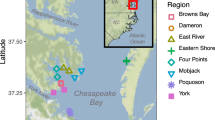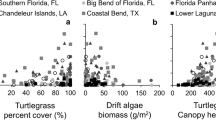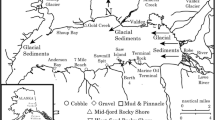Abstract
Tidepools experience significant gradients in ecologically relevant physical variables along the transition from ocean to terrestrial habitat (vertical axis) and from open coast to inner bays (horizontal axis). Associations amongst physical and biological variables, divided into algal, invertebrate and vertebrate (fish) groups, were examined in a tidepool survey dataset. Physical variables and the three biological groups were submitted separately to a principal component analysis (PCA). PCA scores were evaluated with Pearson correlation coefficients across the sampling units (tidepools) to identify significant correlations. Initially little structure in the data and no correlation amongst variables was present. At the onset of summer, correlations were confined amongst physical variables and algal and invertebrate components, followed in the late summer with correlations between invertebrate and fish components. By the fall, correlations were confined to fish and algal/invertebrate components. Species relationships followed a seasonal cycle with a succession from little to no structure, the forming of low trophic level relationships in the early summer to high trophic level relationships in late summer-fall, and deconstruction of structure with the onset of fall-winter storms and ice scour. The seasonal pattern, and well established vertical gradient, has nested within it species composition changes along a horizontal wave energy gradient. The horizontal gradient results in a shift from species which are physiologically adapted to extreme salinities and temperatures to those which are physically adapted to high wave-energy environments.




Similar content being viewed by others
References
Belknap DF, Shipp RC, Kelley JT (1986) Depositional setting and quaternary stratigraphy of the Sheepscot estuary, Maine: a preliminary report. Geographie Physique et Quaternaire 40:55–69
Bell MA (2001) Lateral plate evolution in the threespine stickleback: getting nowhere fast. Genetica 112:445–461
Chen Y, Harvey H (1995) Growth, abundance, and food supply of white sucker. Trans Am Fish Soc 124:262–271
Collette BB, Klein-MacPhee G (2002) Bigelow and Schroeder’s Fishes of the Gulf of Maine 3rd Edition. Smithsonian Institution, Washington
DeGraaf JD, Tyrrell MC (2004) Comparison of the feeding rates of two introduced crab species, Carcinus maenas and Hemigrapsus sanguineus, on the Blue Mussel, Mytilus edulis. Northeastern Naturalist 11(2):163–167
Griffiths SP, Davis AR, West RJ (2006) Role of habitat complexity in structuring temperate rockpool ichthyofaunas. Mar Ecol Prog Ser 313:227–239
Jackson DA (1993) Stopping rules in principal components-analysis–a comparison of heuristic and statistical approaches. Ecology 74(8):2204–2214
Jordaan A (2010) Fish assemblages spatially structure along a multi-scale wave energy gradient. Environ Biol Fish 87(1):13–24
Kelley JT (1987) An inventory of coastal environments and classification of Maine’s glaciated shoreline In FiztGerald DM, Rosen PS (eds) Glaciated Coasts, Academic Press, San Diego
Kramer DL, Rangeley RW, Chapman LJ (1997) Habitat selection: patterns of spatial distribution from behavioral decisions. In: Godin J-GJ (ed) Behaviourial Ecology of Teleost Fishes. Oxford University Press, NY, pp 37–70
Lafferty KD, Kuris AM (1996) Biological control of marine pests. Ecology 77(7):1989–2000
Leonard GH, Levine JM, Schmidt PR, Bertness MD (1998) Flow-driven variation in intertidal community structure in a Maine Estuary. Ecology 79(4):1395–1411
Marshall WS, Emberley TR, Singer TD, Bryson SE, McCormick SD (1999) Time course of salinity adaptation in a strongly euryhaline estuarine teleost, Fundulus heteroclitus: a multivariable approach. J Exp Biol 202:1535–1544
Menge BA, Sutherland JP (1987) Community regulation: variation in disturbance, competition, and predation in relation to environmental stress and recruitment. Am Nat 130(5):730–757
Moring JR (1983) Human factors affecting rocky intertidal fishes. Proceedings of the Third Symposium on Coastal and Ocean Management. American Society of Civil Engineers: 1572–1585.
Moring JR (1990a) Seasonal absence of fishes in tidepools of a boreal environment (Maine, USA). Hydrobiologia 194:163–168
Moring JR (1990b) Marking and tagging intertidal fishes: a review of techniques. In: Parker NC et al (eds) Fish-marking techniques. American Fisheries Society, Bethesda, pp 109–116
Moring JR (1993) Check list of the tidepool fishes of Maine. Maine Naturalist 1:155–165
Paine RT (1984) Ecological determinism in competition for space. Ecology 65:1339–1348
Petraitis PS, Fegley SSR, Beal BF (2002) Ecological assessment of the Anemone Cave in Acadia National Park. National Park Service Technical Report. NPS/BSO-RNR/NRTR/2002-11. 56p.
Rangeley RW, Kramer DL (1995) Use of rocky intertidal habitats by juvenile pollock Pollachius virens. Mar Ecol Prog Ser 126(1–3):9–17
Rao CR (1964) The use and interpretation of principal component analysis in applied research. Sankhya A 26:329–358
Roman CT, Jaworski N, Short FT, Findlay S, Warren RS (2000) Estuaries of the northeastern United States: habitat and land use signatures. Estuaries 23:743–764
Ropes JW (1968) The feeding habits of the green crab, Carcinus maenas (L). Fish Bull 67(2):183–203
Shipp CG, Staples SA, LG Ward (1987) Controls and zonation of geomorphology along a glaciated coast Gouldsboro Bay, Maine. In FiztGerald DM, Rosen PS (eds) Glaciated Coasts, Academic Press, San Diego US.
Sidell BD, Johnston IA, Moerland TS, Goldspink G (1983) The eurythermal myofibrillar protein complex of the mummichog (Fundulus heteroclitus)—adaptation to a fluctuating thermal environment. J Comp Physiol 153:167–173
Smith K, Able K (1994) Salt-marsh tide pools as winter refuges for the mummichog Fundulus heteroclitus in New Jersey. Estuaries Coasts 17(1):226–234
Tolimieri N, Levin PS (2006) Assemblage structure of eastern Pacific groundfishes on the U.S. continental slope in relation to physical and environmental variables. Trans Am Fish Soc 135:317–332.
Trussell GC, Ewanchuk PJ, Bertness MD (2002) Trait-mediated effects in rocky intertidal food chains: predator risk cues alter prey feeding rates. Ecology 84(3):629–640
Trussell GC, Ewanchuk PJ, Bertness MD, Stillman BR (2004) Trophic cascades in rocky shore tide pools: distinguishing lethal and nonlethal effects. Oecologia 139:427–432
Underwood AJ (1999) Physical disturbances and their direct effect on an indirect effect: responses of an intertidal assemblage to a severe storm. J Exp Mar Biol Ecol 232:125–140
Zander CD, Nieder J, Martin K (1999) In: Intertidal Fishes: Life in Two Worlds. Edited by Horn, M.H., Martin, K.L.M. and M.A. Chotkowski. Academic Press. San Diego, CA. Pp. 26–53.
Acknowledgements
We would like to thank the National Park Service, United States Geological Survey, Maine Sea Grant and Northeast Consortium for funding this research and providing financial support to AJ and JC. Many thanks to Pamela Bryer, Regina Purtell, Susan Hayhurst and Natasha Hussey for data collection as part of the field team. Comments from two anonymous reviewers, editorial staff of EBF, and Jeanne Brown helped improve the manuscript substantially. This work is dedicated to the memory of John Moring, a friend and colleague we all miss.
Author information
Authors and Affiliations
Corresponding author
Rights and permissions
About this article
Cite this article
Jordaan, A., Crocker, J. & Chen, Y. Linkages among physical and biological properties in tidepools on the Maine Coast. Environ Biol Fish 92, 13–23 (2011). https://doi.org/10.1007/s10641-011-9812-4
Received:
Accepted:
Published:
Issue Date:
DOI: https://doi.org/10.1007/s10641-011-9812-4




